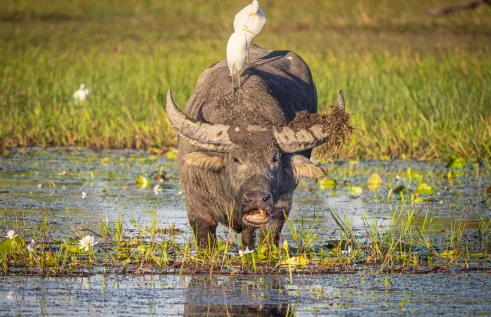Feral animal control has the potential to make money from lowering methane emissions, study finds

New modelling from Charles Darwin University (CDU) researchers has found the control of feral buffaloes could be worth millions in carbon offsets, changing the economics of control programs.
Water buffalo control measures in the Northern Territory have helped protect vital ecosystems in the past but such programs are often too expensive to maintain for long.
But CDU ecologists suggest that this would no longer be the case if it were possible to generate carbon credits by culling the feral animals.
Water buffalo, produce methane through their digestion, a potent greenhouse gas that contributes to global warming.
The researchers ran 20-year simulations of feral water buffalo populations to estimate how much methane production would be avoided on a parcel of land in the South Alligator River region of Kakadu National Park.
The research paper, which was published in Wildlife Research, concluded that the potential value of the avoided methane emissions resulting from controlling water buffalo far exceeded the costs of applying aerial control operations.
CDU and lead author Hugh Davies said this was not about individual ‘bounties’, but about exploring ways to incentivise the ongoing control of large feral ruminants.
“We’re looking at how feral animal control programs impact future populations and what that means for methane emissions over the next 20 years,” Dr Davies said.
“This research is an important proof of concept that ongoing feral ruminant control could be financially viable.”
According to the modelling without control, the methane produced by feral buffalo across the study area would increase from the equivalent of 7792 tonnes of carbon dioxide a year to 97,282 tonnes a year.
Limiting the increase of buffalo numbers through annual aerial control could avoid the release of more than 790,000 tonnes of greenhouse gas over the 20-year simulation (taking into the account the emissions released during aerial control operations).
Estimates of the net worth of this abatement were more than $1 million per year (after subtracting the estimated cost of annual aerial control operations).
“This is just the start of the research, but it throws up some ideas we should consider in carbon offsets,” he said.
“This approach could incentivise the control of numerous destructive feral animals which has often been put in the too hard basket - such as feral camels in the outback, or the booming feral deer populations in Victoria, NSW and Tassie. This is an exciting prospect. It changes everything and would have massive ecological benefits.”
Read the research here.